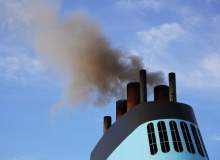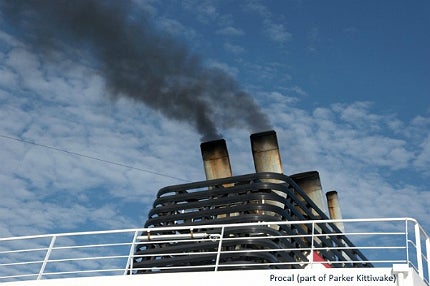

With new international standards forthcoming from the IMO, and a number of regional and national regulators in the process of imposing others, ship emissions are set to face increasingly tougher control in the coming years, as Dr Steve Dye, business development manager at Parker Kittiwake, explains.
“We’re in an era that is witnessing a proliferation of environmental regulations, ever-tighter emission limits and the looming prospect of new regimes for tackling global GHG [greenhouse gas] emissions from shipping.”
He says the likes of the IMO’s MARPOL Annexe VI air-pollution prevention regulations have made monitoring an essential data tool in order to demonstrate that requirements are fulfilled – particularly in light of the EUs recently announced plans to ensure ships using European waters monitor their emissions. Getting it right, he suggests, will be crucial for compliance, but it can also lead to substantial commercial and operational benefits.
“The emergence of emissions benchmarking and vessel efficiency tools show that shipping has taken a huge step forward in becoming more sustainable. However, emissions need to be accurately assessed. While the regulations are being put in place, little is being done about how these regulations will be met.”
Uncertain timetable
It seems there is some uncertainty too, about exactly when these requirements will come into force. Annexe VI had established a time frame for more stringent limits on sulphur and nitrogen oxides (SOx and NOx), but those plans have suffered some setbacks. With the arguments surrounding SOx – particularly the implementation of 2015 IMO regulations requiring low sulphur fuel or SOx scrubbers – rumbling on, the NOx timetable also took a knock at May’s Marine Environment Protection Committee (MEPC) meeting.
How well do you really know your competitors?
Access the most comprehensive Company Profiles on the market, powered by GlobalData. Save hours of research. Gain competitive edge.

Thank you!
Your download email will arrive shortly
Not ready to buy yet? Download a free sample
We are confident about the unique quality of our Company Profiles. However, we want you to make the most beneficial decision for your business, so we offer a free sample that you can download by submitting the below form
By GlobalData“It was anticipated that the committee would agree to a 2016 implementation date for IMO Tier III NOx limits, which would require some sort of after-treatment technology to reduce NOx emissions, such as Selective Catalytic Reduction” (SCR), says Dr Johnny Briggs, of the International Association for Catalytic Control of Ship Emissions to Air (IACCSEA). However, though the IMO committee, which looked at the availability, efficacy and cost of NOx reduction, recommended that the 2016 date be upheld, Russia’s delegation raised questions regarding the technology, asking for the deadline to be postponed to 2021.
“As an association we strongly disagree with the Russian arguments, and we are working with many others to argue the case for 2016,” Briggs says. It all now hangs on the next MEPC meeting in April 2014.
Monitoring for compliance
Whichever date – 2016 or 2021 – is finally chosen for NOx, invariably as emission limits across the board become tighter, achieving them inevitably becomes both more challenging, and more costly. It also means that demonstrating compliance assumes ever greater importance – and that has brought the spotlight to rest firmly on continuous emissions monitoring (CEM).
According to Dye, at the specialist infra-red (IR) and ultra-violet photometric gas detection company Procal – part of Parker Kittiwake – they feel the most effective method for measuring emissions lies in in-situ monitoring, inside the exhaust, using a CEM system.
“In contrast to extractive sampling, where an exhaust gas sample needs to be physically extracted from the system and then analysed, ‘in-situ’ emissions monitoring provides a continuous, real time measurement of the content of exhaust gases. These systems are accurate to a few parts per million [ppm] with gas species-specific ranges from 100 to more than 1000 ppm, depending on what requires measuring. The technology is there to provide instant, accurate CO2 measurement.”
The Procal 2000 uses the reflective beam principle to measure process gas directly, as it enters the sample cell. Mid IR pulses, at two specific wavelengths for each monitored gas, are transmitted through the cell, the ‘reference’ pulse passing through unaffected, while the ‘measure’ pulse is partially absorbed, thus giving a reading of the gas concentration.
Unlike extractive systems, Procal’s patented, sintered metal technology removes the need for filtering and allows the analysis of an unmodified and truly representative gas sample and up to six concentrations can be monitored simultaneously.
The options – laser technology
While Procal’s solution uses an enclosed nichrome filament as its IR source, lasers are another optical approach being applied to in-situ emissions monitoring, with developments in quantum cascade lasers (QCL) helping to make CEM an increasingly realistic proposition for ship owners.
Emsys is one solution which has made steady inroads into the market in the last two years – WR Systems’ unique second generation solid-state, QCL-based approach, which is specifically designed for use on scrubber and SCR-type applications. Offering both gas emissions and particulate matter (PM) measurement, and boasting comprehensive approvals, it covers all current maritime standards.
According to the company, it has the lowest operating costs in the industry, is virtually maintenance free and retro-fitting can be completed in just three days. Installed within the funnel space, the system can monitor up to ten exhaust stacks – with each requiring only one penetration for both gas and PM sampling – and measure up to eight gases simultaneously.
“Emsys is designed to integrate into the vessel’s systems and become another supplier of data to allow optimisation of efficiency and ensure compliance,” says Simon Brown, director for International Maritime Business at WR Systems. “Having NOx, SOx, CO2, CO, CH4 and PM as measured gases, it can provide operational efficiency for engines and boilers operating on all fuel types.”
The system has been ordered for a number of new-builds by shipyards in China, South Korea and Japan, as well as featuring significantly in retro-fit applications.
Quantum cascade
The aptly named Cascade Technologies offers another laser-based solution, with novel patented methods developed to expand the scope of gas detection achievable by QCLs to include simultaneous multiple gas measurement and hundred-thousand-counts-per-second capability.
The system uses direct absorption spectroscopy to detect NO, NO2, SO2, CO2 with other gases such as CO, NH3, CH4 also available, if required. Using a narrow-band, low-noise, coherent QCL source brings significant improvements in sensitivity and selectivity to this established gas-sensing technique, as well as making the system immune to cross interference and providing a swift response time.
GPS and emission control
The introduction of emission control areas (ECAs), where stricter limits apply, forms another part of the global drive towards stricter environmental controls on shipping, and lends added importance to tying emission monitoring with global positioning. CEM solutions are, accordingly, increasingly featuring electronic charting GPS interfaces, while Dr Dye says the ability of CEM systems to measure down to the equivalent of 0.1% sulphur fuel will be key in confirming compliance with SOx regulations.
“This will also be a major issue, when it comes to the wider use of the Arctic shortcut. Environmental organisations are fighting for stricter regulations and emissions monitoring is something to watch out for. Similarly, if fuel switching is the chosen option, monitoring provides assurance that fuels have been changed in a timely manner before entry into an ECA and that compliance is ongoing.”
The good news is that many in the industry have grasped the commercial importance of this issue, and are not simply sitting back and waiting for regulators to tell them what to do.
“Owners and operators can no longer continue to rely on disputable data methodology and accuracy to assess their emissions,” he says.
Related content
The Prius of the Sea – world’s largest hybrid ferry recharges green travel
By September 2013, the largest hybrid vessel ever built, The Prinsesse Benedikte, will transport passengers and vehicles with a new lithium polymer battery system, that will improve Scandlines’ bottom line and its environmental impact.
Ship recycling – EU draft regulations spell hope for a growing controversy
Globally, around 1,000 large ships a year are broken up and recycled.



